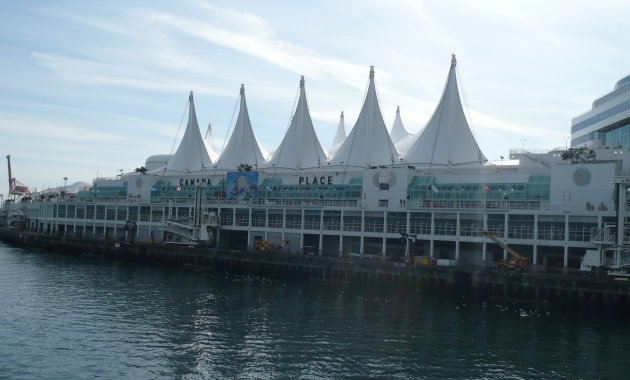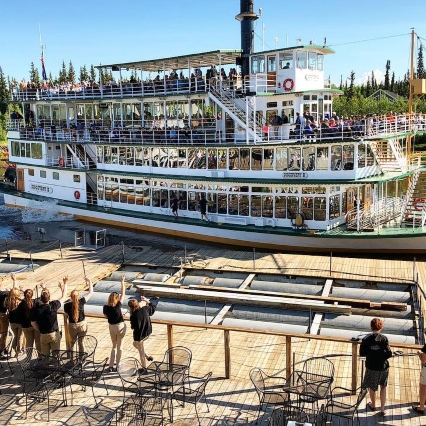Walk a mile in my shoes
A Vancouver walking tour with the Tour Guys is a delightful and educational experience

The Tour Guys are great go-to guys if you want to book a highly interesting historic walking tour of downtown Vancouver. Naturally, they are not just guys (the company employs female tour guides too!); in any event, the tour guides I encountered on a recent visit to Vancouver were all young, energetic and very informed, with plenty of fun facts at their disposal.
The tour I took focused on the Gastown and waterfront areas of Vancouver, and here are some of the things I came away with. These are just a few tidbits; if you take a similar walking tour, you'll learn much, much more.
The Tour Guys offer weekly public tours; private tours and school tours can also be arranged. (Check their website at www.tourguys.ca).
On the waterfront
I discovered that the Vancouver Convention Centre is actually two buildings close to each other on the downtown waterfront. The older building served as Canada Place during the 2010 Winter Olympics.
The Vancouver Convention Centre has been awarded the prestigious LEED (Leadership in Energy and Environmental Design) platinum status. How did it achieve that honour? Well, the toilets in the convention centre use rainwater harvested from the roof; there are gardens on the roof, complete with bee farms to help keep the plants alive; seawater is incorporated into the heating system; and wood from trees damaged by the mountain pine beetle was used in the building's construction.
The cost? A cool $960 million.
I learned that Coal Harbour, as its name implies, was once very much an industrial harbour; today, numerous high-rise condos overlook the same harbour, indicative of the real estate explosion that started in Vancouver after Expo '86 and never really stopped.
I was told by our friendly tour guide that the reclusive billionaire Howard Hughes once stayed at the downtown Westin Bayshore hotel. He is reported to have said, "This is nice. I'll take the top two floors." He made the Bayshore his home for exactly six months minus a day. Why minus a day? Well, if he had stayed a full six months, he would have been subject to paying Canadian taxes. (Maybe that's how you get to be a billionaire!)
I learned that there are expansion points built into streets and buildings to allow for tide shifts and potential earthquake tremors.
I was informed that some 60,000 float planes per year depart from Vancouver's waterfront, many of them bound for B.C.'s capital city, Victoria, on Vancouver Island.
I noticed lots of plaques along the harbourfront with information about Vancouver's many colourful characters.
So far, the tour had been outside, but our guide also took us inside the fabulous Art Deco-style Marine Building with its hand-engraved plaster depictions of the flora and fauna of the Pacific Northwest. The building was completed in 1929 but, thanks to the stock market crash of that year, sat empty for many years until the Guinness family bought if for a bargain-basement price of $900,000 (it cost about $3 million to build). Also featuring inlaid wood, brass and stained glass, the heritage building does feature one "mistake" in the form of an upside-down ship in one of the wall tiles. Our guide told us this was deliberate, to avoid the jinx of the perfect building.
The art of expression
I also saw a good deal of interesting art. There is, for example, a somewhat controversial sculpture called The Drop by the group of German artists known as Inges Idee, controversial because of its cost and a very modernist design that was not to everyone's liking (it is, essentially, a very, very big blue drop, constructed of steel, Styrofoam and polyurethane, and shaped llike a raindrop).
Much less controversial, in fact beloved by most Vancouverites as well as visitors, is artist/author Douglas Coupland's giant whale sculpture, entitled Digital Orca, that looks, from a distance, as if it might have been constructed from black and white Lego blocks.
One of the more intriguing art installations downtown is a poem by U.K. conceptual artist Liam Gillick, which wraps around the southern and eastern exteriors of the Fairmont Pacific Rim hotel building. (Our tour guide said that buildings over a certain size are required by the City of Vancouver to include a public art component in their construction.)
The text, in stainless steel Helvetica bold type, continuously repeats around floors five through 22, and reads as follows: "lying on top of a building the clouds looked no nearer than when I was lying on the street . . ."
(This building, by the way, is also sadly known as the place where Canadian-born actor Cory Monteith, who starred in the TV series Glee, died of a drug overdose in his room on the 21st floor on July 13, 2013).
Out and about in Gastown
Our tour group headed through the old waterfront railway station to enter Gastown, the oldest part of Vancouver. This station, by the way, is home to the first international Starbucks location, that is, the first Starbucks built outside of the United States.
As we strolled about this lovely area, our tour guide offered a sobering thought: apparently, the entire Gastown/Chinatown area almost got bulldozed in 1972 to make way for development projects. It may have been the only time in history that the Communist Party and the Vancouver Board of Trade agreed on something; both groups opposed the proposed development, the guide noted.
Look closely and you'll see that many of the historic Gastown buildings are "protected" by carved sculptures on the building fronts. The carvings depict everything from lions to native elders, mythical Greek figures to (ironically) the very politicians who once did their level best to destroy the area.
Gastown is also home to the old Woodwards building, which has been reinvented as a mix of market-value and social housing, and features an interesting photo mural entitled Abbott & Cordova that depicts the Gastown Riot of August 1971.
Also in Gastown is Gaoler's Mews, site of Vancouver's first jail in the mid-1800s (gaol is the archaic spelling of jail), where the drunk tank reportedly worked on the honour system.
And if you're into some serious shoe shopping, be sure to check out Vancouver shoe designer John Fluevog's JF Shoes Gastown store. Interestingly, it is housed in a "non-permanent" glassed-in space between two heritage buildings. Why non-permanent? Well, that's because the area's heritage status doesn't allow for the construction of permanent new buildings, according to our obliging tour guide.
Finally, I should mention that Gastown is named after John "Gassy Jack" Deighton, a Fraser River pilot turned saloonkeeper. Deighton was the first settler on the site from which the city of Vancouver would evolve. Why was he called Gassy Jack? Not for the reason you might imagine; the nickname actually derived from his reputation as a non-stop talker. In Victorian times, you see, "to gas" meant to talk a lot.






